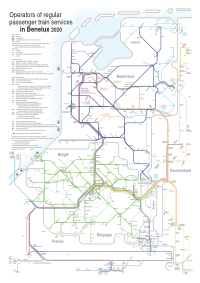Currently a minimal train schedule is being run in Belgium due to the COVID-19 pandemic. See this page on maps of the situation since Monday 23 March 2020. Weekdays thereafter are probably going to be very similar. Do not travel unless absolutely necessary! And practise social distancing!
Travelling around Belgium by train
Currently a minimal train schedule is being run in Belgium due to the COVID-19 pandemic. See this page on maps of the situation since Monday 23 March 2020. Weekdays thereafter are probably going to be very similar. Do not travel unless absolutely necessary! And practise social distancing!
Greetings! Here are some tips on travelling by train in/to/from/through Belgium. See also the home page for tips on train travel in Benelux in general; not all tips about Belgium in that page are repeated here.
Belgium is België in Dutch, Belgique in French, Belgien in German, and Belsch in Luxembourgish. The official language is Dutch in the north, French in the south, bilingually French and Dutch in Brussels, and there is also a small German area in the far east. (There are also other regional languages/dialects.) For the convenience of those who are not familiar with the linguistic situation in Belgium, the boundaries of the language areas, and the place names in their Dutch/French/German etc. versions are shown in the maps.
This is the webpage of the federal government of Belgium, and the tourism websites of Flanders, Wallonia, and Brussels. (There is no tourism organisation for the whole country.) Also outstanding is the tourism website for East Belgium (Eupen-Malmedy).
Jump to:
- Passenger rail service operators
- Types of train services
- Ticketing matters
- Breaking, detours, zones, and fares
- Accessibility issues
- Other public transport operators
- Train deals with the Netherlands
- Train deals with Germany
- Train deals with Luxembourg
- Train deals with France and England
- Tourist railroads
- Disclaimer
Passenger rail service operators
A number of companies run passenger rail services in Belgium. The following map shows the coverage of the various railway companies in Belgium (plus the Netherlands and Luxembourg).
Operators of non-high-speed and semi-high-speed trains:
- NMBS/SNCB (Dutch: Nationale Maatschappij der Belgische Spoorwegen, French: Société nationale des chemins de fer belges 'National Company of the Belgian Railways'; domestic website, android, iOS; international website, android, iOS): the Belgian national railway company; runs all but a few trains in Belgium. NMBS/SNCB's own network extends into all neighbouring countries.
- The Brussels – Amsterdam/The Hague InterCity is run together with NS (Dutch Rail; domestic website, android, iOS; international website, android, iOS). These trains run on the Antwerp – Rotterdam high-speed rail line, and many also on the Rotterdam – Schiphol high-speed rail line. The ones that go through the Rotterdam – Schiphol high-speed rail line are classed as Intercity direct (ICd) in the Netherlands. This Brussels–Amsterdam/The Hague service is commonly called the 'Benelux train'. This is a semi-high-speed service: the trains run on high-speed rail, some sections of which are not served by other non-high-speed train types, but they are not capable of doing 200+ km/h.
- The Libramont – Bastogne-Nord bus service.
- CFL (domestic website; android, iOS; international booking website, android, iOS): the Luxembourgish national railway company. Near the border, CFL runs trains every half or one hour everyday to Athus in Belgium. (Luxembourgish domestic ticketing is extended to Athus, i.e. free in second class from 1 March 2020.) On weekdays, CFL runs a few peak services to and from Gouvy in Belgium.
- Intercity Brussels/Namur/Arlon – Luxembourg is run by NMBS/SNCB. Local trains between Arlon/Kleinbettingen and Luxembourg are run by NMBS/SNCB or CFL
- Intercity Liers – Luxembourg is run together by CFL and NMBS/SNCB.
- Nightjet: Brussels – Innsbruck and Brussels – Vienna sleeper trains (coupled) run by ÖBB (Austrian Rail; webpage, android, iOS). Starts on 19 January 2020.
High-speed rail service operators:
(Unless otherwise indicated, at Brussels-Midi/Zuid ('Brussels-South') these depart from platforms 3/4/5/6, where there is often security control, but no border control.)
- ICE International: Brussels-Midi/Zuid – Brussels-North – Liège-Guillemins – Aachen Hbf– Cologne Hbf (– Cologne/Bonn Airport) – Frankfurt Airport – Frankfurt Hbf. ICE International is a consortium between DB (German Rail) and NS (Dutch Rail). International and domesitc travel within Germany follow German long-distance ticketing rules (e.g. dynamic pricing). If travelling domestically within Belgium (Brussels – Liège), there is an ICE surcharge on top of Belgian domestic ticketing (see below).
- TGV of SNCF (French Rail): Brussels-Midi/Zuid to Lille Europe and many other destinations in France like Paris CDG Airport, but not the terminal stations in central Paris. Follows French long-distance ticketing rules (e.g. dynamic pricing).
- Thalys: {[Marne-la-Vallée – Paris CDG] / Paris Nord} – Brussels-Midi/Zuid – Antwerp-C – Rotterdam C – Schiphol Airport – Amsterdam C; Paris Nord – Brussels-Midi/Zuid – Liège-Guillemins – Aachen Hbf – Cologne Hbf – Düsseldorf Hbf (– Düsseldorf Airport) – Duisburg Hbf – Essen Hbf (– Dortmund Hbf). Seasonal trains to Bourg Saint-Maurice (winter), Marseille (summer), and Bordeaux (summer). The first and second shareholders are SNCF and NMBS/SNCB respectively. It has its own ticketing.
- IZY: low-cost service between Brussels-Midi/Zuid and Paris Nord by Thalys. Runs half on high-speed rail line, and half on conventional rail line. It has its own fare structure, and tickets can only be booked through the IZY website or the SNCF website.
- Eurostar: London St. Pancras (– Ebbsfleet I) (– Ashford I) (– Calais Fréthun) – Lille Europe – Brussels-Midi/Zuid; London St. Pancras (– Lille Europe) – Brussels-Midi/Zuid – Rotterdam C – Amsterdam C. Majority owned by SNCF. It has its own ticketing. Eurostar services to the Netherlands depart from platforms 3/4/5/6. Eurostar services to France and England depart from platforms 1/2: passengers to England depart from the main Eurostar check-in area with full border and security checks, while passengers to France (Lille/Calais) go through a separate check-in terminal without border checks. (The carriage for France is segregated from the carriages for England.) Eurostar tickets from Brussels to France can only be booked through the Belgian Eurostar website, at least 2 days before departure. Eurostar tickets to/from the the three stations in England cost the same; a Eurostar ticket booked from one of the three stations allows you to board at the other two stations. Similarly, Eurostar passengers from Continental Europe can disembark at any of the three stations in England. (But not all trains stop at Ebbsfleet or Ashford.)
OUIGO is SNCF's low-cost domestic high-speed service in France. The closest termini for OUIGO from Belgium are Tourcoing (less than 2.5 from the border) and Lille Flandres (both on the Kortrijk – Mouscron – Lille Flandres InterCity line). Two OUIGO stations that are easily accessible from southeastern Belgium are Metz Ville and Lorraine TGV south of Luxembourg.
Types of train services
Video taken in 2018:
The regular non-high-speed services run every half or one or two hours. Based on their stopping patterns, there are the following types of regular non-high-speed train services:
- S train (Dutch: S-trein / voorstadstrein; French: Train S / train suburbain; German: S-Zug / S-Bahn): primarily all-stops service around the five big cities of Brussels, Antwerp, Liège, Gent, Charleroi. Each S train line has a line number: Brussels has S1 to S10, S20, S81; Antwerp has S32 to S34 (S32 is the line to Roosendaal in the Netherlands); Liège has S41 to S44 (S43 is the line to Maastricht in the Netherlands); Gent has S51 to S53; Charleroi has S61 to S64.
- L train (Dutch: L-trein / stoptrein; French Train L / omnibus; German: L-Zug / Nahverkehrszug): primarily all-stops service elsewhere in the country, including the line to Aachen Hbf in Germany. L train and S train in Belgium are similar to the Sprinter/Stoptrein in the Netherlands, and the RB in Luxembourg and Germany.
- P train: irregular train; see below
- ICT train: irregular train; see below
- InterCity (IC): basically only stops at major stations. On certain sections it can become an all-stops service, especially towards the end of the line. Belgian IC trains make extra stops at some sections during the weekend.
- Nightjet: sleeper trains to Austria via Germany.
There used to be an intermediate category called the InterRegio (IR), but this category no longer exists in Belgium. They are all now classified as IC. (IR is similar to RE in Luxembourg and Germany, and Sneltrein in the Netherlands.)
The high-speed services are already introduced above; here are them again with one-line summaries:
- ICE (Intercity-Express): high-speed service between Brussels and Frankfurt
- TGV: high-speed services between Brussels and various destinations in France
- Thalys: high-speed service to Paris, Paris CDG/Marne La Vallée, Essen/Dortmund, and Amsterdam
- IZY: low-cost high-speed service between Brussels and Paris
- Eurostar: high-speed service to Lille/London, and Amsterdam
The following are network maps of the regular passenger rail services in Belgium. In Belgium there are major differences between the weekdays and weekend/holiday networks. For the convenience of those who are not familiar with the language areas in Belgium, boundaries between them are shown in the maps. Official station names are given together with alternative names in various languages. The governments of the different language areas in Belgium rarely make concessions to people who are not familiar with the place names in their language. Belgian trains often cross these language boundaries multiple times in one journey, and change the language used in the announcements accordingly. (They change language even when just passing through a language area without stopping.) Place names in different languages can sound and look rather different. For instance, train announcements and road signs to Lüttich, Luik, and Liège all refer to the same city (in German/Dutch/French). Similarly, Bergen and Mons are names of the same city (Dutch/French), and so are Anvers and Antwerpen (French/Dutch, Antwerp in English).
InterCity and high-speed rail network in Benelux:
Regular local train network in Belgium (and Luxembourg):
Other than the regular trains, there are also many supplementary trains. These are time-tabled irregular train services that run in addition to the regular train services listed above. They often have routing and stopping patterns that are different from the regular services.
- P trains (Dutch: P-trein / piekuurtrein; French: Train P / train d'heure de pointe; German P-Zug / Zug des Spitzenverkehrs). Some are all-stops, some are like InterCity's, and many are somewhat mixed. Most P trains run on weekdays during peak hours, usually in the dominant commute direction, primarily during non-holiday periods. There are some stations and lines that are only served by P-trains, i.e. they get very few trains per day, and only during weekdays. There are also the Sunday P trains, which are aimed at sending students back to their tertiary institution on Sunday evenings during term time. P trains that run before the afternoon peak have train numbers beginning with 7, and P trains that run during or after the afternoon peak have train numbers beginning with 8.
- ICT trains (Dutch: ICT-trein / toeristentrein; French Trein ICT / train touristique). These are additional trains to and from popular holiday destinations, especially the coast. NMBS/SNCB can add extra ICT services to the coast or other tourist attractions in short notice. The ICT services are primarily run during the holiday periods. ICT trains have train numbers beginning with 66, 67, 68, or 69.
The following are network maps of the supplementary passenger rail services in Belgium. Included in the weekday P train map are S trains (i.e. they have S train line numbers) that are functionally P trains: they are run in addition to the regular P trains, and have train numbers that begin with 7 or 8 like P trains.
Supplementary train network in Belgium:
You may be interested in the printed timetables of the Belgian passenger railway system (Dutch, French). Also available are printed timetables for just InterCity (Dutch, French), and for just S trains (Dutch, French). (They are not necessarily up to date; always check the NMBS/SNCB website or app for the latest information.)
These are the timetable spreadsheets for the high-speed rail services in/to/from/through Benelux that I have compiled. (I cannot guarentee their accuracy! Click on the tabs for the various sheets. Timetabling for high-speed rail services is often very irregular, and they often change every few months; always check their websites for the latest information.)
Ticketing matters
Mirroring the complexity of the Belgian railway network, there is a myriad of ticketing options in Belgium. Here I will only introduce the most-commonly encountered ticketing issues.
Channels of purchase
International tickets
NMBS/SNCB International's website and app (android, iOS) are easy to use. Other than inputting the 'from' and 'to' stations, you can also input a 'via' station for international journeys. If it can compute your desired journey, it gives you a list of possible itineraries. You choose one of them, it shows you the details of the journey, and ticket conditions. You press 'book' for the journey that you want to book. You then input your personal details. The payment methods are Visa, MasterCard, Maestro, American Express, PayPal, Bancontact (Belgian debit card), and iDEAL (Dutch bank transfer). If payment is successful, a ticket is issued. For most destinations, an e-ticket is delivered. See ticket delivery methods.
Some ticket offices/counters can handle international tickets. In 20+ stations, they offer the full range of international tickets offered by NMBS/SNCB International. In another 20+ stations, they can handle tickets to international destinations in the vicinity or destinations directly reachable from there (see here for a list of such stations). Other than purchasing tickets at a ticket counter, tickets can also be purchased via telephone. For ticket purchase at a ticket counter or via telephone, in many cases they charge a service fee of €5/€9/€14 (see here). Tickets purchased via telephone, or tickets purchased online that cannot be delivered as an e-ticket, can be picked up for free at 48 Belgian stations and 6 Dutch stations. (For tickets that can be issued as an e-ticket, but you choose to pick it up at a station, there is a handling fee of €6.)
The range of international tickets that Belgian ticket machines can handle is very small, and all of them are for trips just across the border. All NMBS/SNCB ticket machines in Belgium sell tickets for their own local train services to Maastricht and Roosendaal in the Netherlands, and Aachen Hbf in Germany. For Lille, Aulnoye Aymeries, and Maubeuge (France), and Luxembourg, only the ticket machines at their respective border regions sell cross-border tickets to them. (The cross-border tickets to France are cheaper than the normal international tickets, but the special price cross-border tickets to Luxembourg has been scraped since Luxembourg made public transport within Luxembourg free on 1 March 2020.) The Belgian ticket machines do not sell tickets to Breda and other destinations further north on the IC service to the Netherlands.
Tickets purchased from NMBS/SNCB train conductors, and fines
Domestic and some cross-border tickets can be purchased on board NMBS/SNCB trains. However, buying a ticket on board incurs a fee of €7. See that page for exceptions; the main exceptions are:
- you buy a diabolo fee (Brussels Airport-Zaventem station access fee; €5.4).
- you buy a ticket departing from the following places outside Belgium: Maastricht, Maastricht Randwyck, Eijsden, Roosendaal (Netherlands), Aachen (Germany), Lille (France), and any station in Luxembourg.
Notice that the list of exempted foreign departure points DOES NOT include: a) Aulnoye Aymeries and Maubeuge in France (buying tickets on board will incur the €7 onboard surcharge, and you will be sold a ticket at the normal international rate); b) Breda and destinations further north on the Intercity from Amsterdam/The Hague (without a valid ticket on board in the Netherlands, you may get a fine of €50). Although you do not have to pay the onboard surcharge at Lille, since late 2019(?), only normal international fare tickets are sold by SNCB train conductors.
Go to a train conductor before they come to you. If you don't have a valid ticket and fail to buy a ticket on board, you will get a fine of €75 in Belgium.
The ticket that you get from a train conductor is an RFID card (contactless card). If you need a receipt, or need to read the data of an RFID card issued to you, you can tap the card on the card reader at a Belgian ticket machine. An RFID ticket issued on board cannot be used to travel from Belgium to a neighbouring country.
Domestic tickets via the NMBS/SNCB app
At the NMBS/SNCB domestic app (android, iOS), you start by using the journey planner. If you press a suggested itinerary that is purely domestic, and involves only NMBS/SNCB trains, at the bottom of the suggestion is a button which says 'buy ticket'. Check the details of the ticket: Product (i.e. ticket type), From, To, Number of passengers (1 to 6), Date, Type/Class (single/return/1st class/2nd class). 'Via' is not possible with Belgian domestic tickets. Breaking of journey along the shortest route between the 'From' and 'To' stations is allowed, but if you make a detour, you have to buy two separate tickets (see below). Pressing tick on the top right corner gets you to a confirmation screen. The price is also given on the same screen. Press tick again, and you'll have to input the personal details of the principle traveller: first name, last name, date of birth, and e-mail address. (Only the personal details of the principle traveller is asked.) Methods of payment are Visa, Mastercard, American Express, and Bancontact (Belgian electornic payment). After the transaction is succesfully processed, the ticket is stored in the app. You have to show the mobile ticket from the app in a smart phone, or tablet computer, when asked by a train conductor. The principle traveller also has to be ready to show their ID; the personal details of the principle traveller in the ticket has to match that in their ID.
Domestic and cross-border tickets via the NMBS/SNCB website
This is the domestic ticketing webpage. You fill in the journey details and the personal details of the traveller(s). Payment methods accepted are:
- Card: Mastercard, Bancontact, BNP Paribas Fortis, American Express, Visa
- Belgian bank transfer: ING, Belfius, KBC, CBC
The delivery method is pdf, or, for a purely domestic journey, Belgians can choose to have the e-ticket recorded electronically in their Belgian national ID card (you input the ID card number before payment).
In contrast to the domestic app, which is only for domestic journeys, the domestic ticketing webpage can handle tickets to/from Aachen Hbf, Eijsden, Maastricht Randwyck, Maastricht, or Roosendaal. Just type one of these foreign station names into the 'From' or 'To' blank. The only delivery method is pdf in this case.
Domestic and cross-border tickets via Belgian ticket machines and ticket counters
Some stations have ticket counters. They sell the whole range of domestic tickets (except internet-only tickets). The ticket counters at these stations can sell international tickets. They may charge a ticket-issuing fee for international tickets.
There are ticket machines at all Belgian stations. In Germany and the Netherlands, there are Belgian ticket machines at Aachen Hauptbahnhof, Roosendaal, Maastricht, and Maastricht Randwyck (but apparently not at Eijsden). You can choose from Dutch, French, German, and English language at the ticket machines. They take Visa, Bancontact (Belgian cards), MasterCard, Maestro, and American Express. Some also take coins.
They sell the whole range of domestic tickets (except internet-only tickets). The range of international tickets that they sell is very limited: tickets to Aachen Hbf, Maastricht, or Roosendaal on NMBS/SNCB trains (i.e. not high-speed trains) can be purchased from any ticket machines in Belgium; special cross-border tickets for Lille, Aulnoye Aymeries, Maubeuge, or Luxembourg on NMBS/SNCB trains can only be purchased at their respective border regions. The Belgian ticket machines in the Netherlands and Germany have a somewhat restricted range of tickets on offer. For instance, the NMBS/SNCB Rail Pass, which is not valid outside Belgium, is apparently not sold there.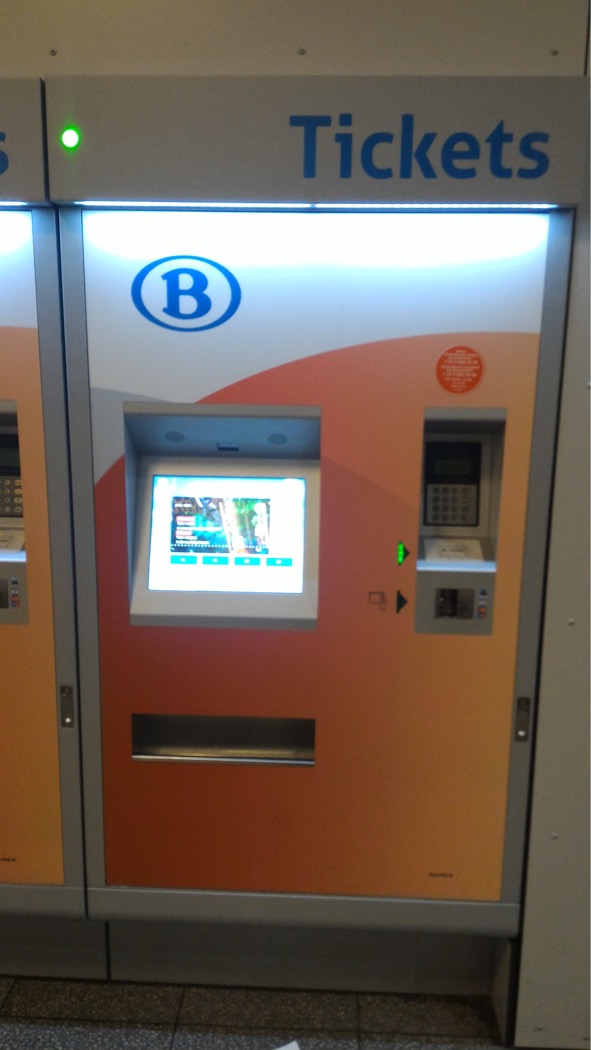
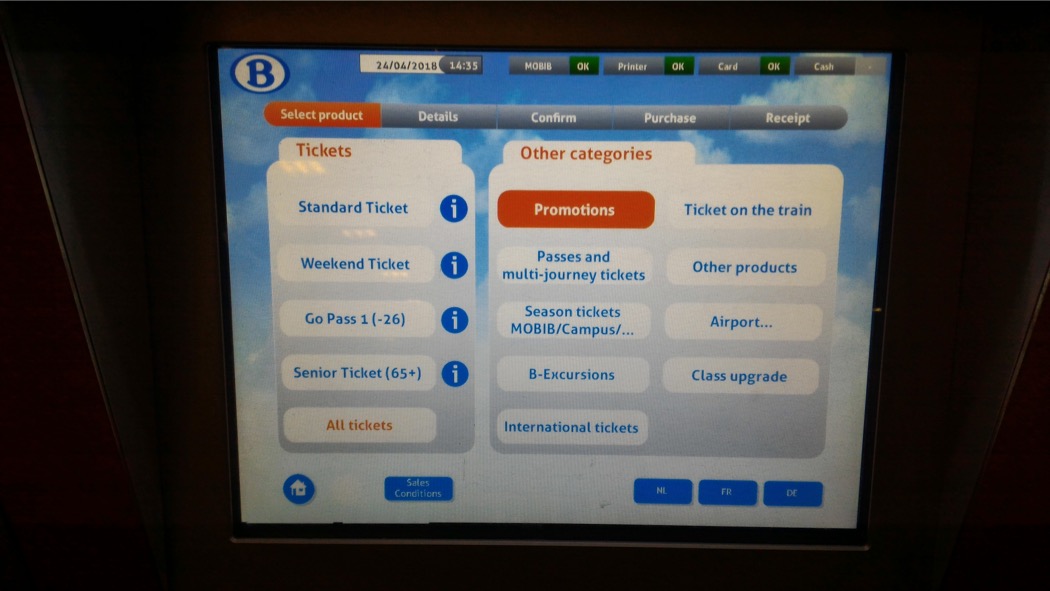


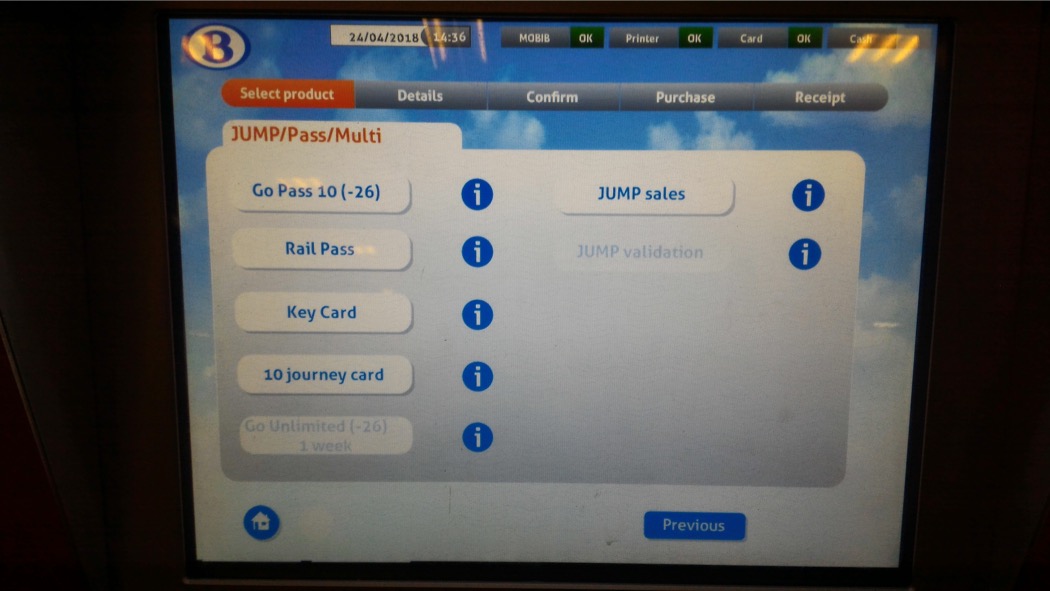
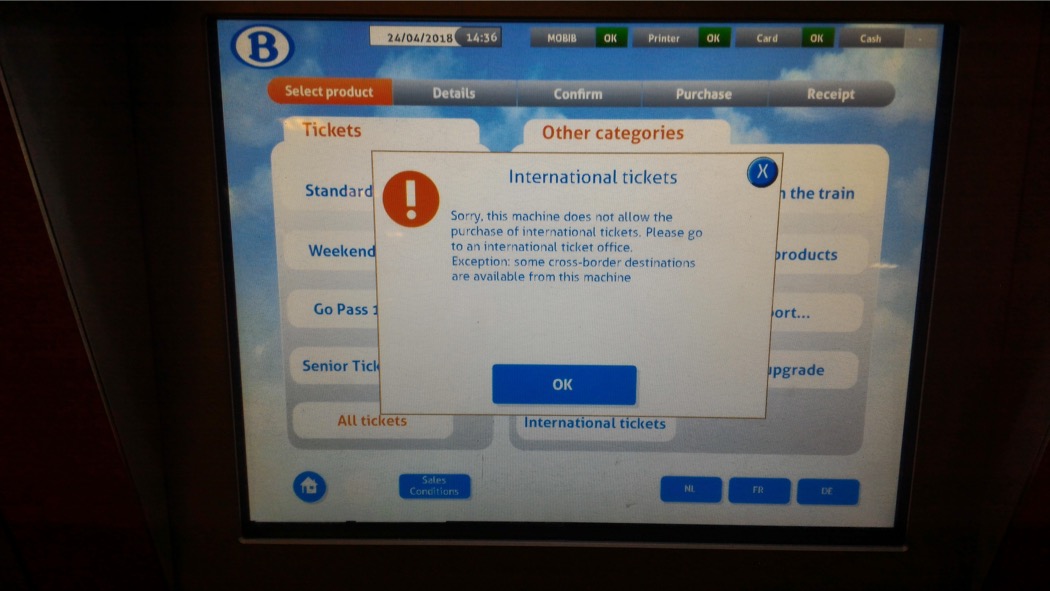
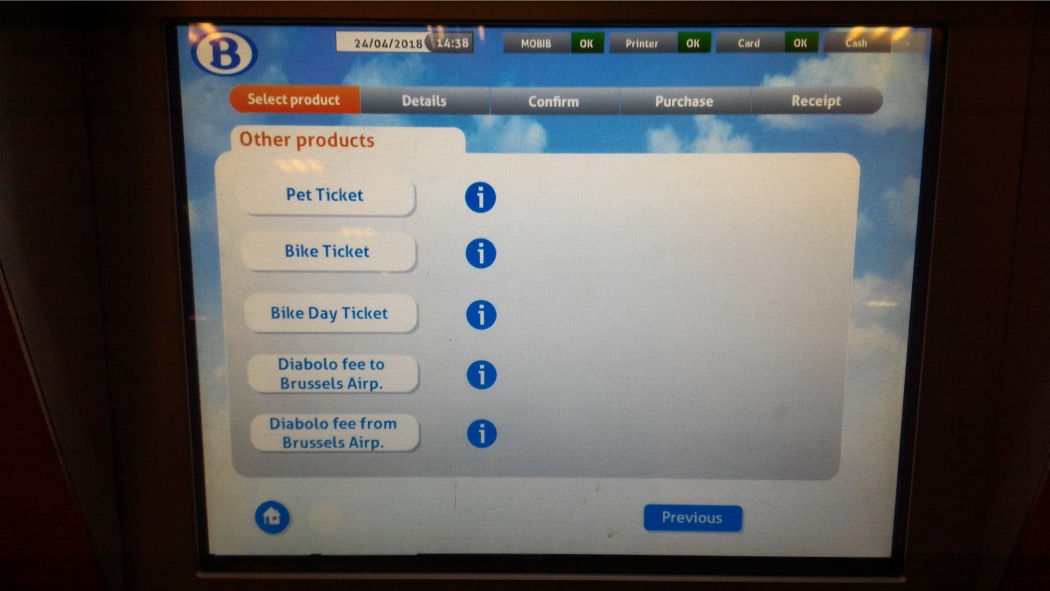
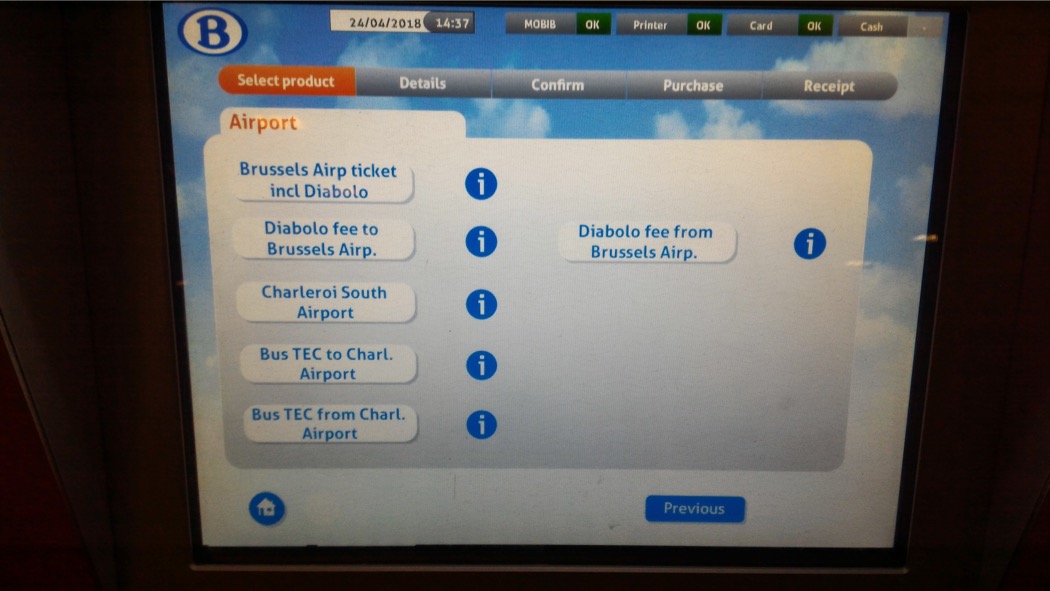
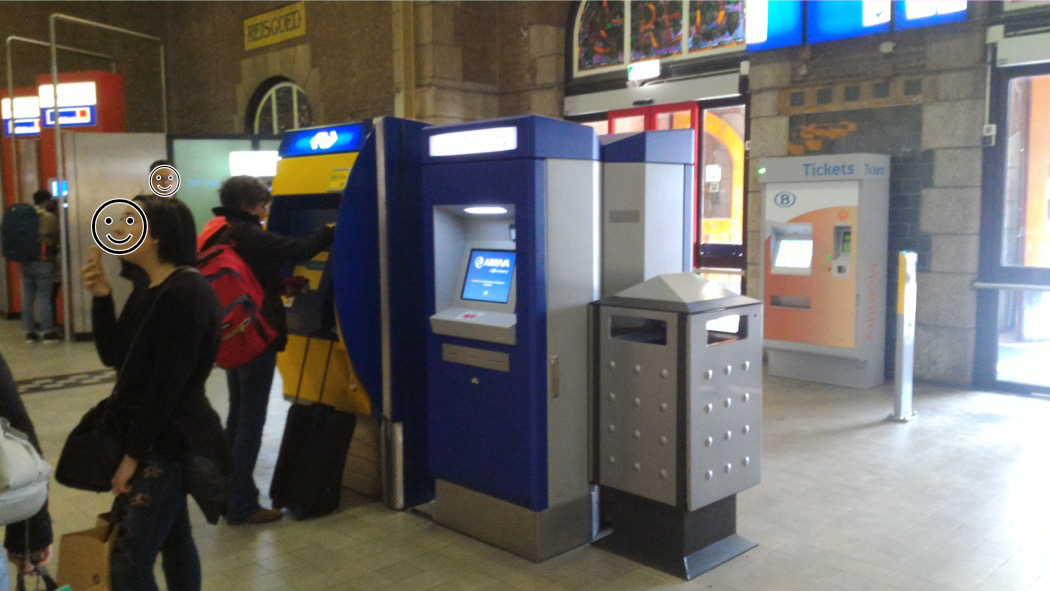
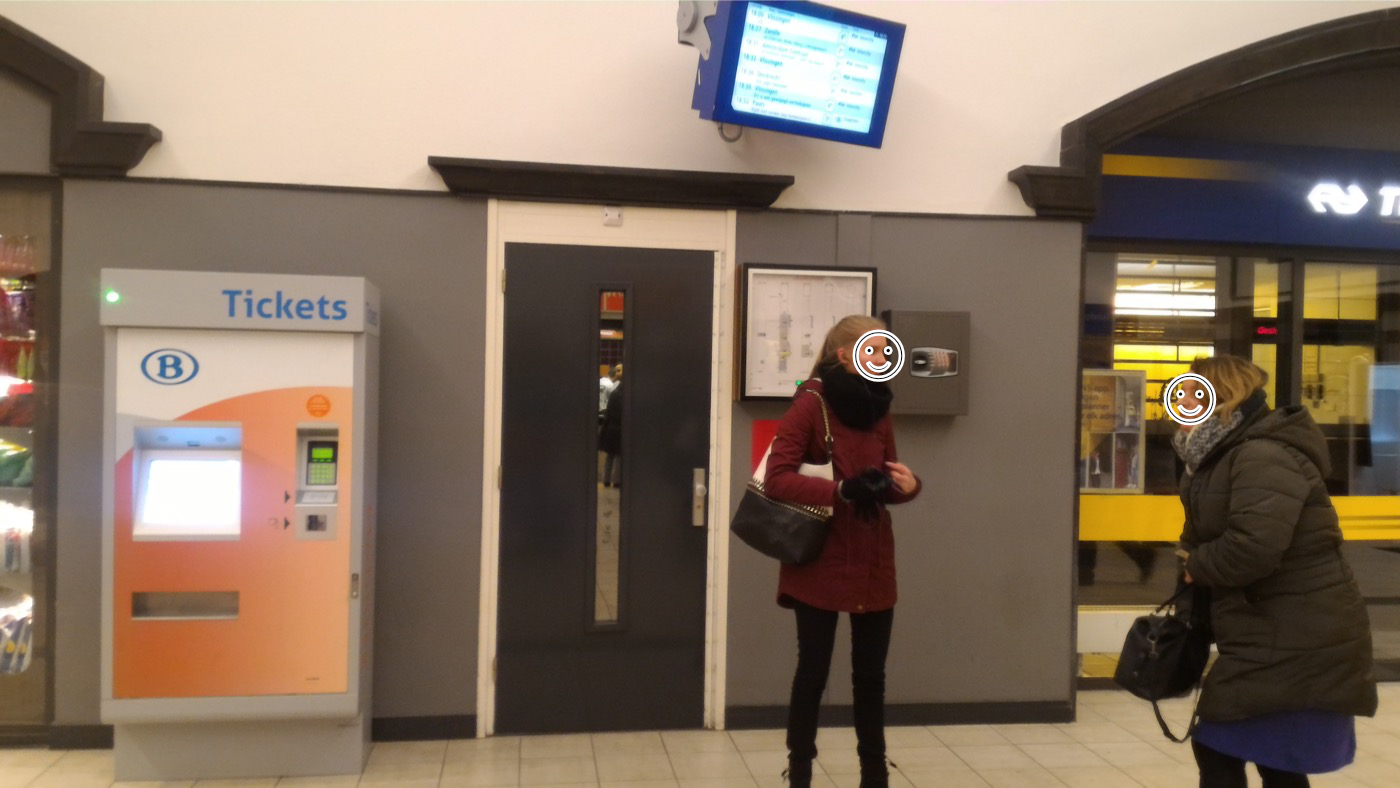
Types of tickets: domestic and cross-border
There is a plethora of ticket types sold by NMBS/SNCB for domestic and short-distance cross-border journeys. Here I will only introduce the commonnest domestic tickets. Between 25 February and July 2020, NMBS/SNCB is gradually changing the names of many of its tickets. Some names have been regularised, and in many cases the separate Dutch and French names of a ticket have been replaced with a single English name.
- Standard Ticket (old names: Standaardbiljet / Billet Standard / Standardfahrkarte): full fare single/return tickets. Return is just double the price of a single ticket.
- Weekend Ticket (old names: Weekendbiljet / Billet Week-end / Wochenendfahrkarte): weekend (Friday from 19:00, Sat, Sun) return ticket for basically the same price as a normal one-way Standard Ticket. Also valid on certain other days, e.g. during long weekends (see the Weekend Ticket page for the exact dates of these holidays.
- Standard Multi (old name: Rail Pass): €83 second class or €128 first class for any ten one-way trips within a year, on NMBS/SNCB trains between any two Belgian stations. (The section between a frontier point and the closest Belgian station is not included.) Can be used by multiple passengers at the same time.
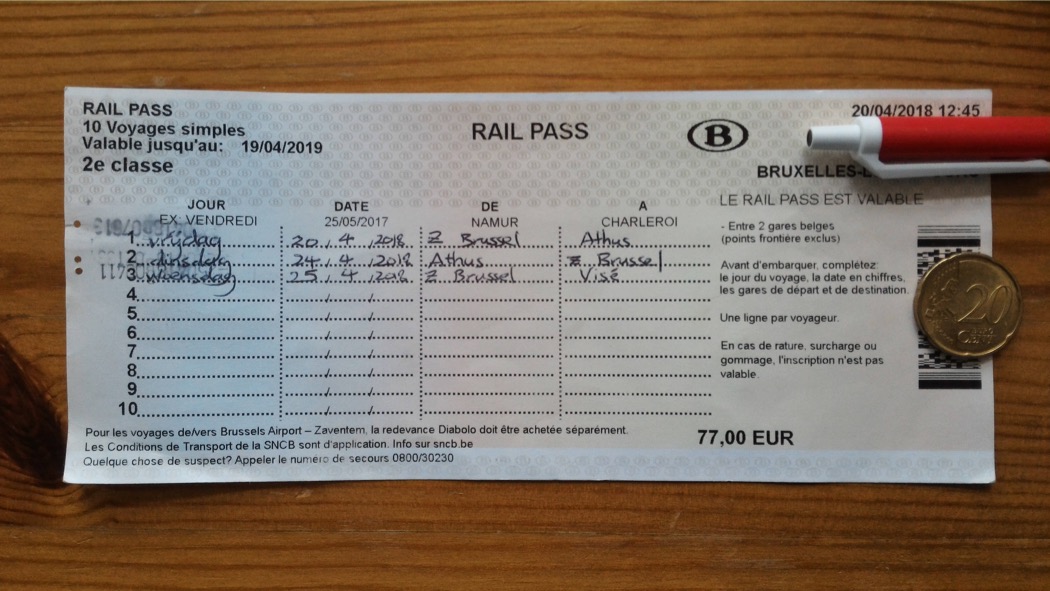
A partially filled NMBS/SNCB Rail Pass - 10 same journey card (10 identieke rittenkaart / Carte 10 trajets identiques / Karte 10 identische Fahrten): 10 one-way trips between two pre-nominated stations. Can be used by multiple passengers at the same time.
- Local Multi (old name: Key Card): €24 second class or €31 first class for 10 short one-way trips within six months, within the 'Key Card validity area' of a pre-nominated station. Check the pdf in that page for the Key Card area from each station. The Key Card can be used by multiple passengers, including pets on leash, at the same time. (For Brussels: Zone Brussels is included in the Key Card area of stations just outside Brussels, but the Key Card is not available from the Brussels-Capital Region itself; use the JUMP ticket instead.)
- JUMP ticket. JUMP tickets are timed tickets that are valid with NMBS/SNCB and the other three Belgian public transport operators within the Brussels-Capital Region. (The airport is NOT included!) JUMP tickets need to be loaded into a MoBIB card (Belgium's RFID contactless card). For anonymous MoBIB cards, it is easiest to get one from STIB-MIVB. For catching NMBS/SNCB trains, a JUMP ticket can be validated by tapping the MoBIB card at the card reader of an NMBS/SNCB ticket machine. (It seems that people don't revalidate at every vehicle that they catch after the first validation. But if you don't revalidate, you risk going overtime accidentally.)
- Kids Ticket (old names: Child Ticket / Biljet Kind / Billet Enfant / Fahrkarte „Kind“): half price for children 11 years old or younger. Children 11 years or younger do not need a ticket if they are accompanied by a passenger 12 years or older with a valid ticket; each such older passenger can accompany at most four ticketless children 11 years or younger. Each extra child, or a child not accompanied by a passengers 12 years or older, needs a child ticket.
- Youth Ticket (old name: Go Pass 1): for people 25 years old or younger, €6.6 one-way second-class journey between any two stations in Belgium.
- Youth Multi (old name: Go Pass 10): for people 25 years old or younger, €53 for ten second-class one-way trips within a year on NMBS/SNCB trains between any two stations in Belgium. Can be used by multiple young passengers at the same time.
- Youth Holiday (old name: Go Unlimited): for people 25 years old or younger, during the Spring / Easter / Summer / Autumn / Christmas holiday, €15 for 7 consecutive days, or during the Summer holiday, €25 for 31 consecutive days of unlimted train travel between any Belgian stations. One needs a personalised MoBIB card to load this ticket in. Go Unlimited CANNOT be combined with an international/cross-border ticket in the same train!
- Senior Ticket (old names: Seniorenbiljet / Billet Seniors / Seniorenfahrkarte): for people 65 years or older, €6.8 second class/ €14.4 first class return journey between any two Belgian stations. Usually it is valid from 09:00 on weekdays, and the whole day on the weekend. However, there are some weekdays when it is valid the whole day, and some days when it is NOT valid the entire day. Check the validity calendar in that page carefully.
- Brussels Airport Supplement (old name: Diabolo fee; see next section).
- Train+bus ticket to/from Charleroi Airport.
- Hi Belgium Pass is a package by Brussels Airlines which includes: a) return flights to Brussels from many European destinations, maximally Thursday to Tuesday over one weekend; b) unlimited travel on NMBS/SNCB trains between any stations in Belgium, including access to Brussels Airport-Zaventem station twice; and c) activity vouchers. An e-ticket is issued for train travel.
- Bicycles and pets: see below.
- Belgian residents who are unemployed or partially employed can get heavily discounted train tickets or reimbursement for train journeys to job interviews or similar activities: for Flanders and Wallonia. For Brussels (French, Dutch), go to an Actiris office and ask for an A14 form.
There is a whole gamma of other tickets and deals; see here.
For short-distance cross-border tickets, see Aachen, Maastricht and Roosendaal, Lille, Aulnoye Aymeries, and Maubeuge, and Luxembourg below.
Surcharges
- Brussels Airport Supplement (old names: Diabolo fee / Diabolotoeslag / Redevance Diabolo / Diabolo-Zuschlag): station-access supplement for Brussels Airport-Zaventem station. €5.40 if purchased separately, or €5.44 if intergrated into another ticket, for each access (passing the station gates in or out once) by each passenger. See also the Diabolo fee page on who is exempt from this fee. A diabolo fee purchased from a train conductor does NOT incur the €7 on-board surcharge.
- Using ICE domestically in Belgium requires a surcharge of €8 second class or €12 first class on top of a normal domestic fare. This surcharge can only be purchased at an international ticket office (?).
Bicycles and pets
Fully folded up folding bicycles travel for free. Otherwise, a Bike Supplement (Fietssupplement / Supplément Vélo / Fahrrad-Zuschlag) (old names: Bike ticket / Fietsbiljet / Billet Vélo / Fahrradfahrkarte) is €4 one-way, or €8 for a day ticket (dagkaart / carte 1 jour / Tageskarte). A bicycle ticket is not valid, i.e. bicycles are not allowed to board/deboard trains, at Brussels-Central, Brussels-Chapelle/Kapellekerk, and Brussels-Congres. Bicycles are also not allowed on the Libramont – Bastogne NMBS/SNCB bus line. See also the domestic train/bike page, domestic bike on train page (Dutch / French) and the international FAQ.
The bike supplment is valid on domestic trains, as well as NMBS/SNCB services to Roosendaal, Maastricht (Netherlands); Aachen (Germany); Maubeuge, Aulnoye Aymeries, Lille (France); Luxembourg. On the other hand, on the IC service to the Netherlands via Breda, the charge is €12.
Pet Supplement (Huisdier Supplement / Supplément Animal Domestique / Haustier-Zuschlag) (Old names: Pet Ticket / Huisdierbiljet / Billet Animal / Haustierfahrkarte) is €3 for each non-contained pet per domestic journey. On their website they also advertise for separate pet tickets for Roosendaal, Maastricht, Aachen Hbf, but they are also €3 per journey.
(The website lists a separate pet ticket for Luxembourg, of unknown price, and it is a return ticket which can only be obtained at the border region. However, the relevant clauses of the Luxembourg pet ticket have been deleted on 15 August in the 2019 NMBS/SNCB tariff tables. As for the French destinations, there is no mention of pet tickets on the NMBS/SNCB website.)
The carriage of pets is free for animals in a container 55×30×30 cm not occupying a seat. Assistance animals also travel for free, but a free pass has to be processed through an assistance animal organisation. See also the domestic Travel with your pet page (Dutch / French), and the international FAQ.(Bicycles and pets travel for free on domestic public transport journeys in Luxembourg. People also travel for free on public transport (second class) in Luxembourg from 1 March 2020.)
Summary of purchase channels and ticket types
NMBS/SNCB provides this summary for the various channels of purchase and types of tickets.
Breaking, detours, zones, and fares
Breaking and detours
By default, you travel on the shortest possible route in distance between the 'from' and 'to' stations. In this case, you are allowed to break your journey: feel free to stop at an intermediate point, and join a later train to continue your journey. The ticket is valid until the last service of the day. (You are responsible for checking whether there are still services that allow you to complete the journey; make no assumptions on how late trains might run till.)
In some cases, you are allowed take a route that is not shortest in distance. However, in these circumstances, you are not allowed to break your journey (you can make the necessary train changes, but not leave the station). You can take a route that is not the shortest in the following situations:
- if you can get to your destination faster. (The length of travelling time is shorter.)
- if you can avoid changing trains, and can stay in the same train, and if this journey is maximally 30 minutes longer than taking trains along the shortest route in distance.
- you can backtrack along a route if by doing so, you can get to your destination faster, or if there are no connecting services right at the point where the two tracks intersect, or if there is a delay.
Otherwise, you are not allowed to make a detour. If you want to make a detour, you have to purchase two spearate tickets. In the NMBS/SNCB journey planner, sometimes it gives you suggested itineraries with a warning saying that you have to buy two separate tickets for the suggested journey.
Zones, 'non-zones', and fares
Some stations are grouped together into 'Zones'. There are 21 such Zones in Belgium; the largest of which is the Brussels Zone, covering the same area as the Brussels-Capital Region. (The station of Linkebeek, which straddle the border of Brussles and Flanders, lies outside the Brussels Zone.) These zones are indicated in the maps above as mauve polygons. Each of these Zones is a single tariff point. A domestic or international ticket which has a Zone as its origin and/or destination gives the traveller, on the ticket's day of validity, free travel on NMBS/SNCB trains within that Zone until one leaves that Zone. (When purchasing a ticket, when you type in a station within a Zone, I think the resulting ticket automatically has the name of that Zone as the origin/destination.) In a Rail Pass or similar ticket, you can put down a Zone as the origin and/or destination.
A ticket with Mortsel, Mortsel-Liersesteenweg, Mortsel-Oude-God, or Mortsel-Deurnesteenweg as its origin/destination has equal validity in the other three Mortsel stations. However, Mortsel is not a Zone, e.g. a ticket to one of the Mortsel stations does not give limitless travel amongst the Mortsel stations.
NMBS/SNCB tickets to/from Maastricht, Maastricht Randwyck, and Eijsden cost the same, and has equal validity at the other two stations. However, Maastricht is also not a Zone. NMBS/SNCB tickets to/from these three stations usually just say 'Maastricht'.
An NMBS/SNCB return ticket from anywhere in Belgium, Roosendaal, the Maastricht stations, or Aachen Hbf to a coastal station (kuststation / gare du littoral) allows the traveller to return from another coastal station. The coastal stations are: Knokke, Duinbergen, Heist, Zeebrugge-Dorp, Zeebrugge-Strand, Blankenberge, Oostende, Veurne, Koksijde, and De Panne. Basically the entire coast is linked by the Kusttram 'Coastal Tram'. Ticketing of De Lijn, the Flemish public transport company, applies on the Coastal Tram.
Most of the points above are mentioned in the NMBS/SNCB glossary, which can be found in the NMBS/SNCB terms and conditions (Dutch, French). Also in the terms and conditions are the tariff tables. For ordinary single tickets, 1 to 3 km have the same fares, and distances longer than 150 km are charged 150 km on domestic NMBS/SNCB services.
Accessibility issues
This is the NMBS/SNCB disability page.
Assited boarding is available at more than 130 stations. Request can be made by dialling +32 2 528 28 28, or online (domestic page, international page). Domestic requests has to be made at least 24 hours beforehand. If the trip is a direct journey between some 40 larger stations, the notice needed is reduced to 3 hours (see a list of these 40+ stations in the disability page). For international travel, request has to be made at least 48 hours beforehand. Before making an international request, TGV, Thalys, and Eurostar offer special wheelchair fares for wheelchair users and their carers. Phone +32 2 432 38 01 to make this booking.
There are various special domestic deals for people in certain categories, e.g. carers, people with visual impairment, people with hardship / lower income, and people with difficulties walking/standing.
The disability pages of the three other public transport operators in Belgium:
Other public transport operators
Other than NMBS/SNCB, there are three other public transport operators in Belgium:
- De Lijn (Flanders; network maps)
- STIB-MIVB (Brussels; network maps)
- TEC (Wallonia; network maps)
Their networks overlap a little bit. Some Belgian buses cross into neighbouring countries, and some foreign buses cross into Belgium.
NMBS/SNCB has various subscriptions that combine travels on their trains and each of these three other public transport operators.
All four Belgian public transport operators use an RFID card called MoBIB. However, for NMBS/SNCB and De Lijn, they only use personalised MoBIB cards for subscriptions. STIB-MIVB and TEC, on the other hand, use MoBIB cards for both subscriptions and timed tickets.
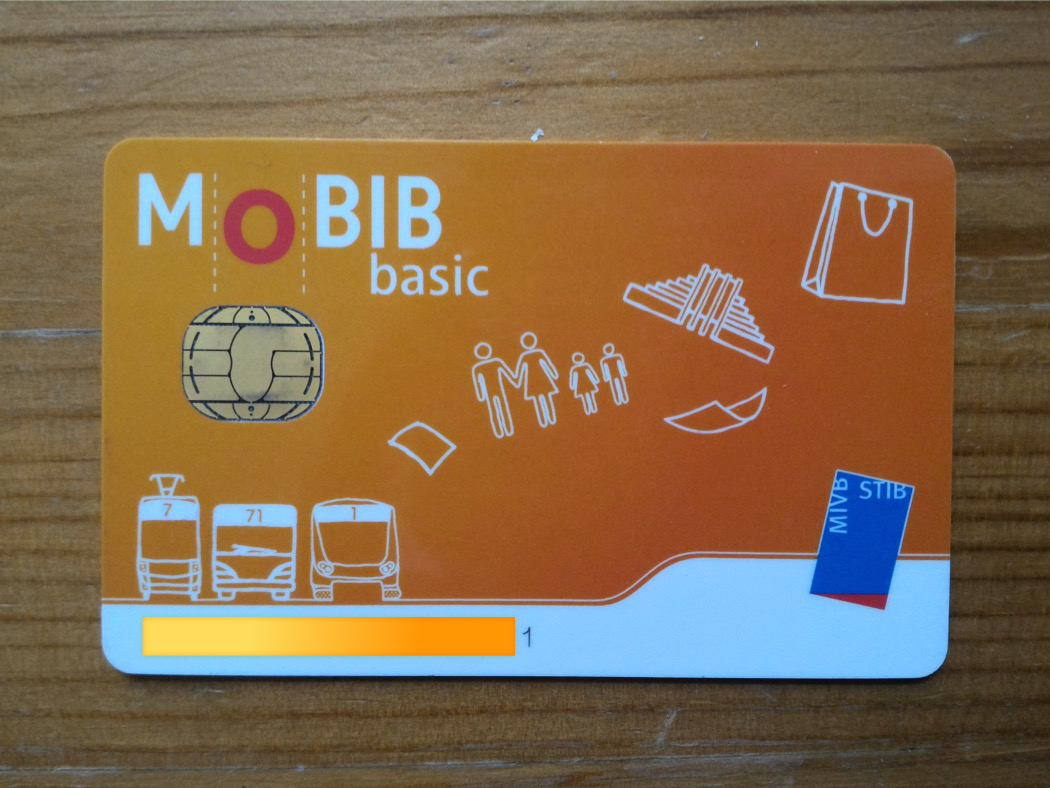
Train deals with the Netherlands
Also read further in the Netherlands page, especially for domestic travel in the Netherlands.
Special short-distance cross-border tickets
There is a range of tickets to Roosendaal and Maastricht in the Netherlands on the NMBS/SNCB local trains. (NMBS/SNCB tickets for 'Maastricht' covers Maastricht, Maastricht Randwyck, and Eijsden stations, all at the same price level.) Ticket machines in Belgium and the NMBS/SNCB websites (domestic/international) can handle tickets to/from these stations. (But not the domestic NMBS/SNCB app!) There are also Belgian ticket machines at Maastricht and Maastricht Randwyck, but apparently not at Eijsden. The range of tickets available from these ticket machines in the Netherlands is somewhat smaller, e.g. the Rail Pass is apparently not available. In the domestic NMBS/SNCB booking webpage, you just need to type in 'ROOSENDAAL (NL)', 'MAASTRICHT (NL)', 'MAASTRICHT/RANDWYCK (NL)', or 'EIJSDEN (NL)' as the 'from' or 'to' station. (It is not possible to book tickets between these.) The domestic Bike Ticket is also valid on these NMBS/SNCB services. (But a bike ticket does not have a barcode to open the gates at Roosendaal.) A ticket from/to Roosendaal/Maastricht can be used back-to-back with a Belgian domestic ticket on the same train. (Unless it is a ticket like Go Unlimited, which specifically says that it cannot be combined with an international/cross-border ticket on the same train.) For instance, you can use an NMBS/SNCB Rail Pass up till Visé near the Dutch border, and then present another ticket between Visé and Maastricht, while sitting in the same Belgian train. The same can be done up till Essen near the Dutch border (the Essen in Belgium, not the Essen in Germany), and then another cross-border ticket between Essen and Roosendaal. (Terms and conditions for the standard tickets in Dutch and French.)

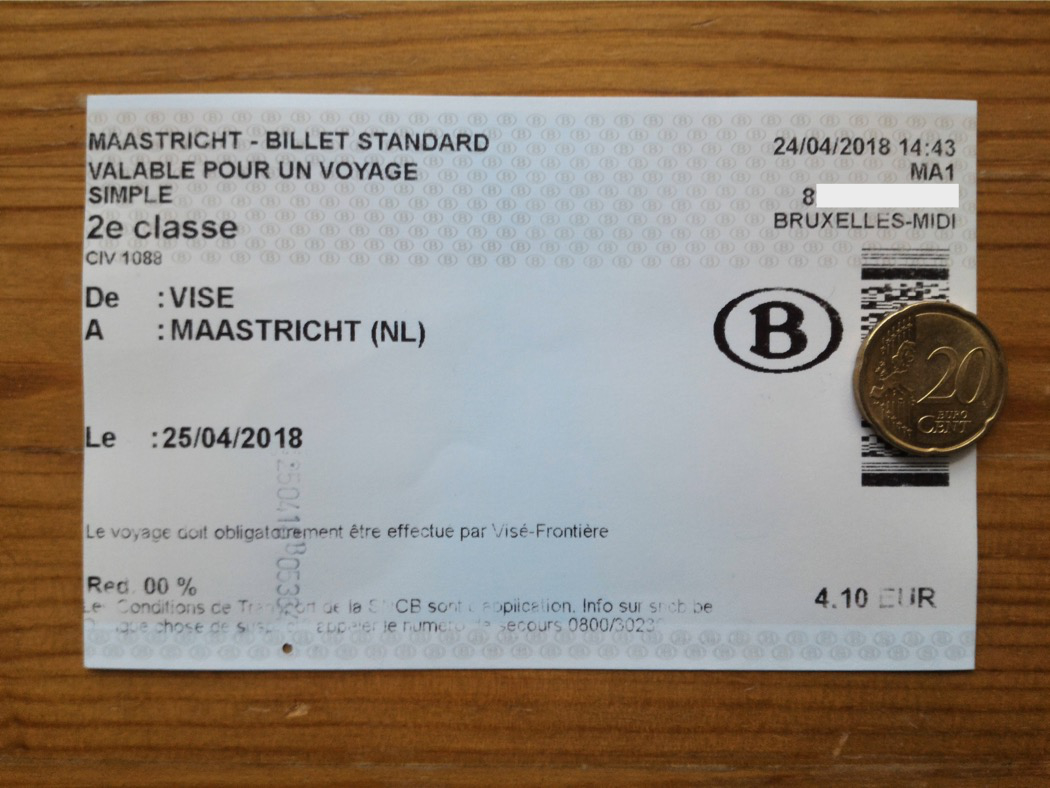
There is also the Euregio ticket, which is valid on many non-high-speed rail services and buses/trams in the Belgium/Netherlands/Germany tripoint region. See here.
Some train stations in the Netherlands have gates. Stations that have gates include Roosendaal, Breda, Amsterdam Centraal, while stations that do not have gates include Maastricht, Schiphol Airport (December 2019). Belgian tickets usually include a barcode for opening these station gates in the Netherlands if the destination requires one.
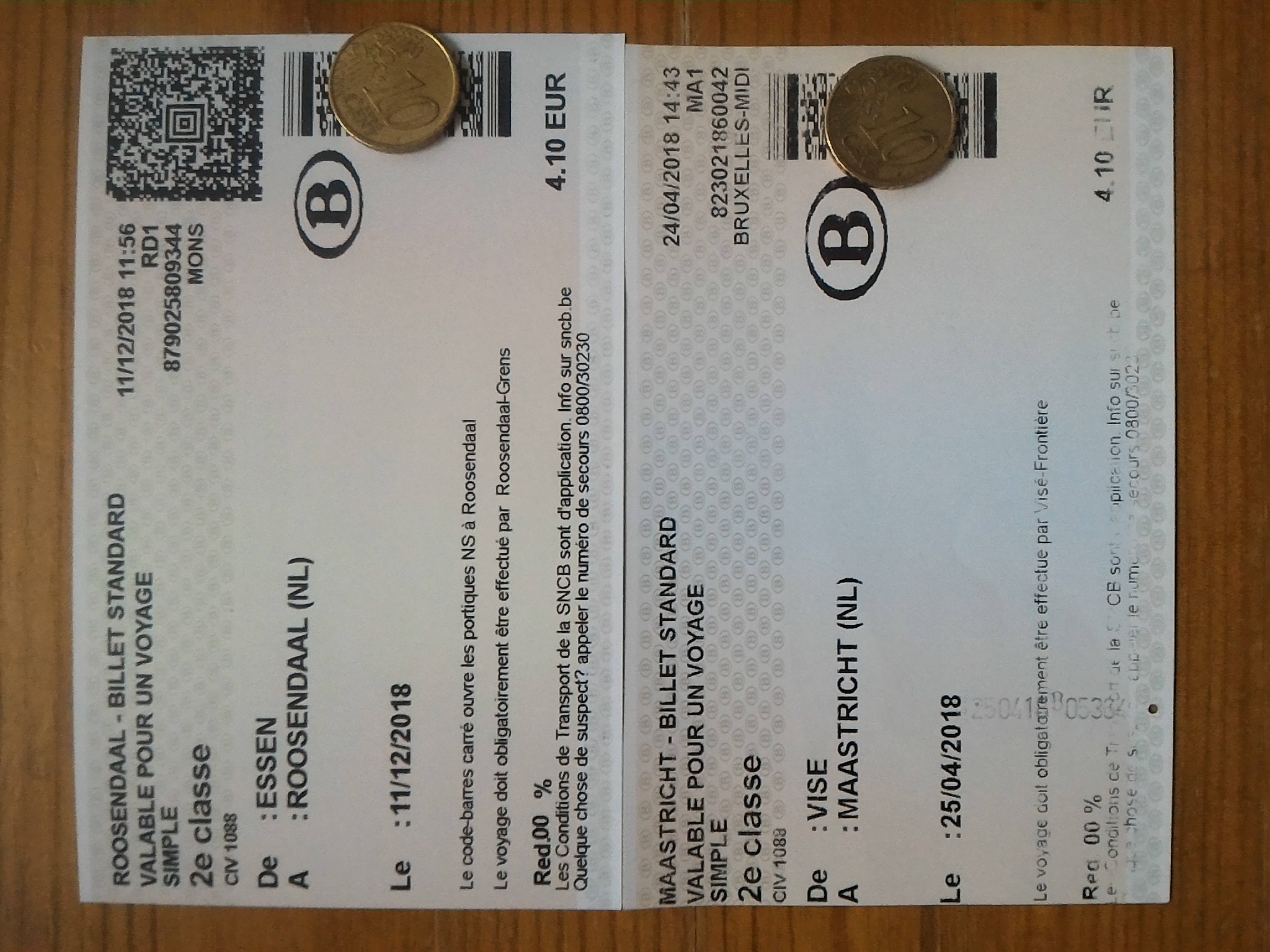
Other international tickets
For non-high-speed train tickets between Belgium and the Netherlands, there is the Early Bird deal: a fixed discount is given (i.e. no need to book too early) if booked seven or more days before the departure date. The discount is on average 40% off full-fare for Monday to Thursday departures, and 20% off for Friday to Sunday departures. These discount tickets are mid-flex, i.e. it is refundable to a degree. The same deal is also given in the Netherlands for non-high-speed travel to Belgium, and to Luxembourg via Belgium. These deals are best booked online: in Belgium, ticket offices and telephone booking usually charge a booking fee; in the Netherlands, ticket machines and the normal ticket counters do not sell discounted tickets, while the international ticket offices and telephone booking charge hefty booking fees for tickets that you cannot get from ticket machines. Children 11 years old or younger travel for free if they are accompanied by an adult 18 years old or older. (Each such adult can take with them at most 4 children for free.)
(If it is just between Belgium and Roosendaal/Maastricht, NMBS/SNCB automatically give you their better fixed-rate fare. In general, if you have to go through Roosendaal or Maastricht, see whether getting Belgian tickets to Roosendaal/Maastricht and then domestic Dutch tickets from Roosendaal/Maastricht is a better deal than getting one ticket the entire way.)
For a small fixed-price (€7.6 second class, €11.6 first class), a Connection ticket on NMBS/SNCB trains can be added to a Thalys or Eurostar ticket to/from the Netherlands. Just book the entire journey through the NMBS/SNCB International website/app. [Not sure whether this is still valid: the Belgian connecting ticket TO a Thalys/Eurostar service can be used on the day or the day before the Thalys/Eurostar service; for a connecting ticket FROM a Thalys/Eurostar service, on the day or the day after the Thalys/Eurostar service.]
Train deals with Germany
Special short-distance cross-border tickets
There is a range of tickets to Aachen Hauptbahnhof in Germany on NMBS/SNCB local trains. (Aachen is Aken in Dutch, and Aix-la-Chapelle in French.) Ticket machines in Belgium and the NMBS/SNCB domestic website (but not the NMBS/SNCB domestic app) can handle tickets to/from Aachen Hbf on NMBS/SNCB trains (but not on Thalys or ICE trains to Aachen). There are also Belgian ticket machines at Aachen Hbf. However, the range of tickets available there is smaller (e.g. the Rail Pass is apparently not available there). In the domestic NMBS/SNCB booking webpage, you just need to input 'AACHEN (D)' as the 'from' or 'to' station. The domestic Bike Ticket is also valid on the NMBS/SNCB L train to/from Aachen. A ticket to/from Aachen can be used back-to-back with a Belgian domestic ticket on the same train. (Unless it is a ticket like Go Unlimited, which specifically says that it cannot be combined with an international/cross-border ticket on the same train.) For instance, you can use an NMBS/SNCB Rail Pass up till Hergenrath near the German border, and then present another ticket between Hergenrath and Aachen Hbf, while sitting in the same Belgian train. (Terms and conditions for the standard tickets in Dutch and French.)
An interactive map of the local train lines in the state of Nordrhein-Westphalia 'North Rhein-Westphalia' (NRW) is here.
Unlike the widespread 'incursion' of German local public transport and ticketing into the border areas in the Netherlands, German local ticketing is very rarely valid in Belgium. The Aachen regional AVV-Tarif and the state-wide NRW-Tarif are NOT valid on the NMBS/SNCB line to Aachen Hbf.
(With buses, the only bus line where normal local German tariff is valid for some distance in Belgium is ASEAG bus 24 between Kelmis Bruch in Belgium and Aachen Bushof in Germany. In other cases, normal German tariffs stop at the first bus stop before or after the border. Joint German–Belgian bus fare in the Aachen area is handled through a special tariff called region3tarif. The next two German public transport authorities to the south of AVV, VRS (Cologne/Bonn) and VRT (Trier), have no bus services to Belgium, although some are right on the border. The Belgian–German border area south of the Aachen region lies in the Eifel mountain range, and is very lightly populated in general.)
There is the Euregio ticket, which IS valid on the NMBS/SNCB line to Aachen Hbf, plus many other non-high-speed rail services and buses/trams in the wider Belgium/Netherlands/Germany tripoint region. See here.
See the Germany section in the home page for the local transport tickets that cover the whole Germany.
Other international tickets
For ICE tickets between Belgium and Germany (or beyond), with the Sparpreis Europa and Super Sparpreis Europa saver fares, the price is said to be the same to/from any Belgian train stations; in other words, a free train journey on NMBS/SNCB trains connecting with the ICE service is included. Just input the actual origin and destination stations when booking an ICE ticket. See the FAQ on this from NMBS/SNCB International.
However, what NMBS/SNCB International says on this is not entirely true: NMBS/SNCB is quite generous with the Sparpreis free connecting distance that it gives from the ICE stations in Brussels and Liège, but for the western and southern extremities of Belgium, the Sparpreis can be bumped up by €10 or €20. For stations further away from Brussels or Liège, it is best to compare the price for Brussels/Liège, and the price for the intended origin/destination; if the price is different, find out at what point from Brussels/Liège the price is bumped up. The free connecting distance is not the same for all ICE services.
For a small fixed-price (€7.6 second class, €11.6 first class), a Connection ticket on NMBS/SNCB trains can be added to a Thalys ticket to/from Germany. Just book the entire journey through the NMBS/SNCB International website/app. [Not sure whether this is still valid: the Belgian connecting ticket TO a Thalys service can be used on the day or the day before the Thalys service; for a connecting ticket FROM a Thalys service, on the day or the day after the Thalys service.]
See what DB says about carriage of bicycles in general in Germany.
Train deals with Luxembourg
Also read further in the Luxembourg page. (Luxembourg here refers to the Grand Duchy of Luxembourg, as opposed to the Province of Luxembourg in Belgium.
Special short-distance cross-border tickets
Public transport within Luxembourg has become zero-fare since 1 March 2020. The special Belgium–Luxembourg cross-border fares have been cancelled. Tickets to Luxembourg cannot be obtained from the usual domestic ticket machines and apps/websites, perhaps except at the following station near the border (where the old cross-border tickets were available):
- Trois-Ponts, Vielsalm, and Gouvy, for journeys via the Gouvy frontier
- Arlon and Messancy, for journeys via the Sterpenich frontier or Athus
- Virton, Halanzy, and Aubange, for journeys via Athus
Otherwise, get a ticket to Luxembourg from the NMBS/SNCB International website/app or at International ticket offices.
There are also special monthly and annual subscriptions. With these subscriptions, more destinations in Belgium are available.
For Athus itself: Athus in Belgium is considered a domestic destination by both Belgian and Luxembourgish rail, i.e. free in second class on Luxembourgish trains. For first class tickets, there are no Luxembourgish ticket machine in Athus, but a ticket can be obtained from the train conductor with a €1 surcharge.
There is a range of special DAY RETURN tickets for short-distance cross-border traffic between Belgium and any station in Luxembourg. For the standard, child, and pet tickets (children and small pets usually travel for free), these day return tickets are only available at the ticket machines and ticket counters at the following Belgian stations near the border (see also the maps above):
Trois-Ponts, Vielsalm, and Gouvy, for journeys via the Gouvy frontierArlon and Messancy, for journeys via the Sterpenich frontier or AthusVirton, Halanzy, and Aubange, for journeys via Athus
For Athus itself: Athus in Belgium is considered a domestic destination by both Belgian and Luxembourgish rail. Second class domestic public transport in Luxembourg is free from 1 March 2020. If a ticket is needed, there are no Luxembourgish train ticket machines at Athus, and train tickets can be purchased from a train conductor with a €1 surcharge.
Other than the special day return tickets, there are also special monthly and annual subscriptions. With these subscriptions, more destinations in Belgium are available.
NOTE: all of these special short-distance cross-border deals between Belgium and Luxembourg CANNOT be used back-to-back with a domestic Belgian ticket in the same train! For instance, DO NOT board the IC from Luxembourg with a special Luxembourg – Arlon day return ticket, AND THEN remain in the same train pass Arlon with a domestic Belgian ticket. Do not even show this intention! You are meant to: a) buy a normal international ticket from Luxembourg pass Arlon; or b) get a full-fare international ticket from Luxembourg to Arlon, and then combine that with a Belgian domestic ticket; or c) catch another train at Arlon. (Terms and conditions for standard ticket in Dutch and French.) CFL issues the same range of day return tickets and subscriptions from any station in Luxembourg to these nearby Belgian stations. They have the same rule on not combining with a Belgian domestic ticket.
Other international tickets
Otherwise you can get normal international tickets, from an international ticket office, from the NMBS/SNCB International website/app, or from the CFL International website/app. (A full-flex Luxembourg > Arlon one-way ticket costs a little bit less than a special day return ticket.) Other than full-flex tickets, there are the following international deals with Luxembourg:
- No-flex weekend return (depart on Fri/Sat/Sun, return on Sat/Sun), and youth single/return (for people 25 years or younger). These give 30% off the full-flex price.
- [Cancelled:]
no-flex return tickets, called Escapade 1/2/3: €55/77/99 second class or €90/140/190 first class for a return ticket within 30 days for 1/2/3 people between any station in Belgium and any station in Luxembourg.
With these normal international tickets, you can use them in combination with another Belgian domestic ticket in the same train, unless it is a ticket like Go Unlimited, which specifically says that it cannot be combined with an international ticket on the same train. (I asked NMBS/SNCB International about this.)
Train deals with France and England
Special short-distance cross-border tickets
NMBS/SNCB has four special short-distance one-way tickets to destinations in France:
- Kortrijk or Zone Mouscron (Mouscron, Herseaux) via the Tourcoing frontier to Lille Flandres
- Tournai or Froyennes via the Blandain frontier to Lille Flandres
- Zone Mons via the Quévy frontier to Aulnoye Aymeries
- Zone Charleroi-Sud via the Jeumont frontier to Maubeuge
(The old Trampoline tickets and subscriptions to Lille has been discontinued. Also note that Lille is Rijsel in Dutch.) These special one-way tickets are available at the aforementioned border Belgian stations, and also in the other direction from the border French stations. From the French regional train ticket machines in the region ('TER', blue in colour), choose FRANCE/BELGIQUE from the home screen for these tickets. (Kortrijk is Courtrai in French. Courtrai and Tournai look and sound somewhat similar; do not get them mixed up. When I was at Aulnoye Aymeries in late 2018, the Mons ticket was not yet available at their machines; I bought my ticket from the ticket counter.)
Belgium classes these train services as Intercity, while France classes these as TER (regional services). The Lille services run all day, while the Aulnoye/Maubeuge services only have two return services per day each (they connect with French domestic TER services to/from Paris Nord).
If you buy your ticket from an NMBS/SNCB train conductor, they only sell you normal international price tickets on these services, and not the special price cross-border tickets. (This is now the case with the Lille services.) If you buy a ticket from an NMBS/SNCB train conductor at Aulnoye Aymeries or Maubeuge, or within Belgium, they charge you a €7 on-board surcharge. The on-board surcharge is not applicable at Lille.
NOTE: these special Lille/Aulnoye Aymeries/Maubeuge tickets cannot be used back-to-back with a domestic Belgian ticket in the same train! Do not even show this intention! For instance, DO NOT board the IC from Lille Flandres with a special cross-border ticket to Kortrijk/Tournai, AND THEN remain in the same train pass Kortrijk/Tournai. Similarly, DO NOT board the IC from Maubeuge with a special cross-border ticket, and stay on the train pass Charleroi-Sud! You are meant to: a) buy a normal international ticket from Lille Flandres pass Kortrijk/Tournai, or from Maubeuge pass Charleroi-Sud; or b) get a full-fare ticket from Lille Flandres to Mouscron/Kortrijk/Froyennes/Tournai, or Maubeuge to Charleroi-Sud, and combine that with a domestic Belgian ticket; or c) catch another train at Mouscron/Kortrijk/Froyennes/Tournai, or Charleroi-Sud. (Terms and conditions in Dutch and French.)
See my TER maps of Nord-Pas-de-Calais!
This is the official webpage of rail maps of France. This is the website of SNCF TER Hauts-de-France (local rail network of the region to the southeast of Belgium), and SNCF TER Grand Est (local rail network of the region to the south of Belgium). Although there are no direct passenger rail links between Grand Est and Belgium, some stations are close to Belgium, e.g. Givet, Longwy.
The following are French bus operators that are based near the Belgian border (many have buses extending into Belgium).
- Pas-de-Calais (closest point to England):
- Calais urban (Kales in Dutch): SITAC
- Pas-de-Calais district bus
- Nord (borders West-Vlaanderen and Hainaut Provinces of Belgium):
- Dunkerque urban (Dunkirk in English, Duinkerke in Dutch): DK'Bus (Connections with De Panne station in Belgium.)
- Lille urban (Rijsel in Dutch): ilevia; also operates metro and trams
- Valenciennes urban (Valencijn in Dutch): Transvilles; also operates trams
- Maubeuge/Aulnoye-Aymeries urban (Mabuse or Malbode in Dutch): Stibus
- Nord district bus: Arc-en-ciel
- Aisne (shares a short border with Hainaut Province of Belgium): district bus
- Ardennes (borders Hainaut, Namur, and Luxembourg Provinces of Belgium):
- Meuse (shares a short border with Luxembourg Province of Belgium): district bus fluo
- Meurthe et Moselle (shares a short border with Luxembourg Province of Belgium):
Other international tickets
From anywhere in Belgium to many destinations in Hauts de France by non-high-speed rail, there is a no-flex weekend return deal (Friday to Sunday departure, Saturday to Sunday return) that is 40 percent off full-fare. There is also a no-flex youth rate (25 years old or under), which is 30 percent off full-fare anytime, single or return. Children 11 years old or younger travel for free if they are accompanied by an adult 18 years old or older. (Each such adult can take with them at most 4 children for free.)
For high-speed travel between Brussels-Midi/Zuid and Lille Europe, NMBS/SNCB International has a high-speed Brussels–Lille subscription, valid on all TGV and Eurostar services. This can be purchased at the international ticket office at Brussels-Midi/Zuid.
For a small fixed-price (€7.6 second class, €11.6 first class), a Connection ticket on NMBS/SNCB trains can be added to a TGV/Thalys/Eurostar ticket to/from France or England. Just book the entire journey through the NMBS/SNCB International website/app. [Not sure whether this is still valid: the Belgian connecting ticket TO a TGV/Thalys/Eurostar service can be used on the day or the day before the TGV/Thalys/Eurostar service; for a connecting ticket FROM a TGV/Thalys/Eurostar service, on the day or the day after the TGV/Thalys/Eurostar service.]
Between Belgium and England, there is the Zeebrugge – Kingston upon Hull passenger ferry. For Zeebrugge, one can apparently walk/cycle between the Zeebrugge ferry terminal and the Zeebrugge stations. However: a) I have read that the Zeebrugge port area is not very pedestrian/cyclist friendly; and b) you have to look up which of the two Zeebrugge stations (Zeebrugge-Strand and Zeebrugge-Dorp) is in use if you are heading landward, and the train frequency is not great. See the ferry link above for their coach service to Brugge.
The plan for an Oostende – Ramsgate ferry service fell through dramatically in 2019; perhaps it will be restarted in the future. Not far from Belgium are Dunkerque (Dunkirk/Duinkerke) and Calais in France, both with multiple sailings per day to Dover. None of these have special rail deals. (The Dunkirk – Dover ferry is vehicle-only, with bicycles included. Dunkirk buses are free (since late 2018; check again before you go), and there is a bus line to De Panne station in Belgium. Perhaps you want to do this with a small folding bike?)
Tourist railroads
The following is a list of rail services in Belgium that: a) are tourist-/enthusiast-oriented; b) run 'between destinations' (e.g., not running entirely within a theme park or grounds of a preservation association); and c) run entirely or mostly on railway not served by regular passenger train services. These touristic rail services run on very limited schedules, and they are also relatively expensive. However, you get to experience the history of rail transport, as they usually run on antique vehicles that are difficult to see elsewhere. Excluded in the following list (currently?) are most historical tramways and narrow-gauge railways. The information below is shown in the weekend local train maps above.
Ordinary Belgian railway ticketing is not valid on them. These services are not aimed at passengers taking luggage with them. Some allow bicycles. Check with the individual organisations.
- In East Flanders Province: Stroomtrein Maldegem–Eeklo, Maldegem – Eeklo. Steam and diesel train rides. While there are regular train services at Eeklo, the rides start at Maldegem. Maldegem can be accessed via: bus 58 Gent-Sint-Pieters – Eeklo – Maldegem – Brugge, bus 87 Deinze – Aalter – Maldegem, bus 45 Knokke – Maldegem (check whether they run on the weekend).
- In East Flanders and Antwerp Provinces: Stroomtrein Dendermonde–Puurs, Baasrode-Noord – Oppuurs. Steam train rides. Both stations are a bit away from Dendermonde/Baasrode-Zuid and Puurs stations, where regular train services are available. Bus 253 links Dendermonde – Baasrode-Noord – Oppuurs – Puurs. There are also bus 245, 252, 254, 257 that runs between Dendermonde and Baasrode-Noord (check whether they run on the weekend).
- In Namur Province: Le Chemin de fer du Bocq, Ciney – Evrehailles-Bauche. Railcar and diesel trains. Regular train services available at Ciney. (The railway line has seemingly not yet been restored to Yvoir.)
- In Namur Province: Chemin de fer à vapeur des 3 vallées. Mariembourg – Treignes. Steam train and railcars. Regular train service available at Mariembourg.
Also fun are Train World at Schaarbeek/Schaerbeek in Brussels, Rétrotrain at Saint Ghislain, and Centre du Rail & de la Pierre at Rochefort-Jemelle.
Disclaimer
I do this as a hobby. I am not a travel agent; while I would be interested in questions that you might have, please direct your questions to the public transport providers involved. Situations and rules can change quickly; please check with the public transport providers for the latest information. I take utter care on the accuracy of the information I provide here, but I cannot be held responsible for any inaccuracies. If you see any doubtful information, comments are welcome: hilario.bambooradical gmail.
Unless otherwise stated, all diagrams and photos are work of mine. Please respect copyright. I apologise for the quality of the photos and videos; I hope that they are good enough for illustrative purposes.
This page in 2021 This page in 2019
Home Be Ne Lux
